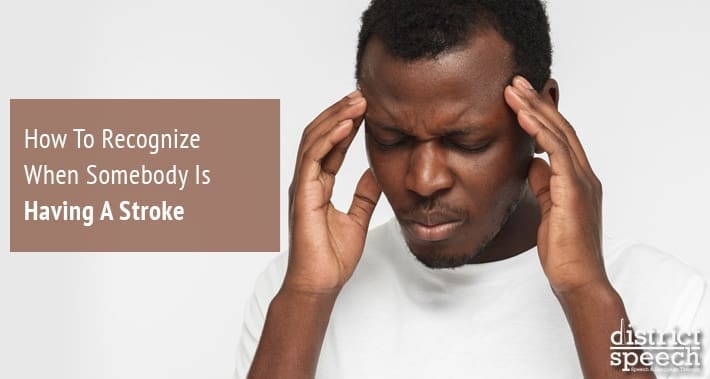
If you you’re wondering if you or someone near you is having a stroke, you’ll want to remember the acronym FAST.
- Face: is a side of your face drooping?
- Arms: if you lift both your arms up, does one drift downward?
- Speech: is your speech coming out unexpectedly different?
- Time: get help immediately
It’s scary if you or a loved one is experiencing a stroke, and the recovery after one can be long and difficult.
Sometimes after having a stroke you’ll have to relearn things that you never thought you’d have to, like how to speak properly and move your body properly.
Speech and language impairment are common after strokes.
In particular, a stroke can cause aphasia, which can affect the way you communicate with and understand others.
If you or a loved one has recently had a stroke, speech therapy for stroke recovery here at District Speech and Language Therapy can help.
Keep reading to find out more about strokes and how you can recognize if someone is having one.
What Happens During A Stroke?
A stroke happens when the blood supply to your brain is blocked or a blood vessel ruptures.
If a blockage occurs or this blood supply is interrupted, you won’t receive oxygen to your brain tissues anymore.
Within minutes, the cells and tissue in your brain will die without oxygen.
There are three main categories of stroke that all have different causes: transient ischemic attack (TIA), hemorrhagic stroke, and ischemic stroke.
If you’re experiencing an ischemic stroke it means that either blood clots or another cause of reduced blood flow causes the arteries supplying blood to your brain to become narrower.
This could be caused by plaque as well.
A transient ischemic attack is when the blood supply to your brain is only blocked temporarily: because of this it is sometimes referred to as a “mini stroke.”
If the arteries bringing blood to your brain either break or leak blood, that’s a hemorrhagic stroke.
How To Tell If Somebody Is Having A Stroke?
The longer your brain goes without oxygen, the worse the damage you’ll experience.
That’s why it’s so important to be able to recognize the early signs and symptoms of a stroke.
The symptoms of your stroke will show up depending on which part of your brain is affected by the interrupted blood flow.
Therefore, there are a quite a few symptoms to look out for.
They can include paralysis, slurred or confused speech, and difficulty understanding others’ speech.
If someone is having a stroke, they may seem confused, become disoriented, or exhibit sudden behavior changes (think uncharacteristic agitation).
They might lose their coordination – for example, suddenly have trouble walking, lose their balance, or express that they’re having vision problems or dizziness.
Seizures, nausea, vomiting, and a sudden severe headache are also symptoms of a stroke.
Remember, if you think you or someone around you is having a stroke, they need immediate medical attention.
Otherwise, you could suffer long term disability, brain damage, or death from stroke.
How To Avoid A Stroke
To avoid a stroke, you have to understand the factors that put you at risk for one.
Some risk factors include:
- Inactivity or a sedentary lifestyle
- A diet high in salt, saturated fats, and/or cholesterol
- Family history of stroke or heart disease
- Your personal health history
Let’s get into more detail about some of the most important ways you can decrease your risk of having a stroke.

1. Quit Smoking
One in five adults is a regular smoker, despite most people understanding the health risks of smoking.
Smoking is known to increase clot formation, and it does so in two ways – by thickening your blood and increasing the amount of plaque that builds up in your arteries.
We all know it’s difficult to quit smoking tobacco products, but to decrease your risk of stroke it’ll have to be one of the first things to go.
This is well proven – a 2010 study by Shah and Cole is called “Smoking and stroke: the more you smoke the more you stroke.”
A title like that is pretty straightforward, after all.
So bust out those nicotine patches and toss those cigarettes in the trash.
2. Keep Your Diabetes Under Control
If you have diabetes, you’ll want to make sure it’s well managed if you want to reduce your risk of stroke.
If your blood sugar is high you could be gradually damaging your blood vessels.
This makes clots more likely to form inside the vessels, leading to greater risk of a stroke.
3. Don’t Drink Too Much
Did you know that a low amount of drinking can actually decrease your risk of stroke?
This was the result of a 2018 study.
On the other hand, heavy drinking increases your risk, according to this 2003 study.
Heavy drinking is more than one or two alcoholic drinks a day – once you get to more than two, your risks go up dramatically.
4. Get Regular Exercise
Exercise is a great way to reduce your risk of stroke, as well improving your overall health.
Even ten to fifteen minutes of exercise at a time a day can make a huge difference – just try to hit at least 30 minutes total.
You don’t want to push yourself too hard though, so aim for a level of activity where you can still talk even if you’re breathing hard.
5. Keep Your Blood Pressure Healthy
Exercise is one way to keep your blood pressure under control, but you’ll want to keep a close eye on it if you want to decrease your risk of stroke.
When uncontrolled, high blood pressure can double or sometimes even quadruple your risk of having a stroke.
If you know you’re prone to high blood pressure, you’ll want to make sure you’re monitoring it closely and intervening with medication if necessary.
Book Your Appointment With District Speech Today
Have you or a loved one had a stroke, and now you’re wondering what the best road to recovery is?
A speech therapist can help you with the speech and language issues you might be having as a result of your stroke.
Book your appointment with District Speech today.
1300 I St NW, Suite 400 E,
Washington, DC 20005
- https://g.page/districtspeech
District Speech and Language Therapy specializes in speech therapy, physical therapy, and occupational therapy solutions, for both children and adults, in the Washington D.C and the Arlington Virginia areas.